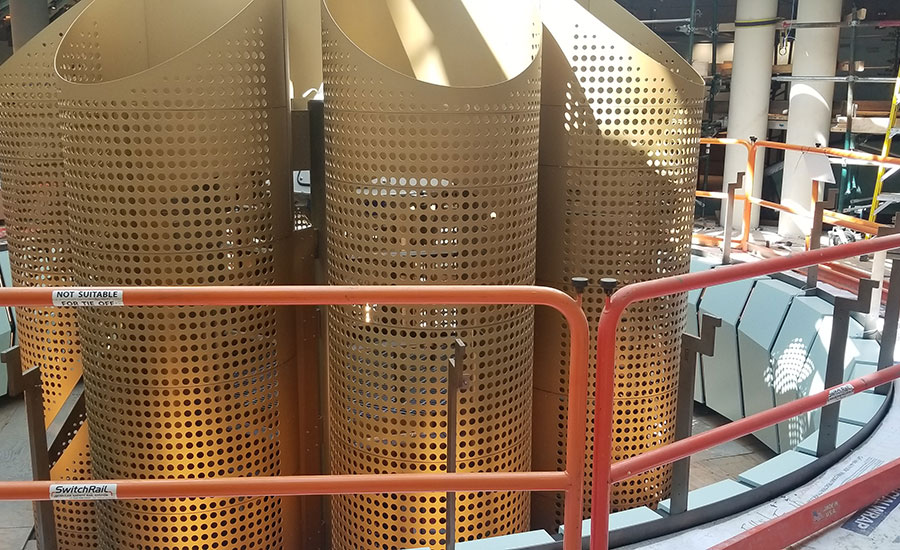Starting this year, a new architectural sheet metal internship program between the Sheet Metal and Air Conditioning Contractors’ National Association (SMACNA) and the American Institute of Architecture Students (AIAS) promises to give architects and sheet metal contractors a new point of view on the design to construction process.
About 20 percent of SMACNA’s membership work in the architectural sheet metal sector. However, that number increases annually with the demand for more exterior and interior architectural metal construction projects.
In conversation, the internship’s organizers — Carol Duncan (CD), CEO of General Sheet Metal, Tom Zahner (TZ), Chair of the SMACNA Architectural Contractors Council and COO at A. Zahner Company, Tom Soles (TS), executive director of member services and market sectors at SMACNA and Kimberly Tuttle (KT), director of partnerships and Events at AIAS — share why they hope a change of view will change the outlook for the sheet metal industry for good.
How long has this partnership between SMACNA and AIAS been in the making?
TS: SMACNA met with AIAS to begin discussions about a student intern program the first quarter of this year in response to a recommendation from SMACNA’s Architectural Sheet Metal Council.

What was AIAS’ goal in specifically partnering with SMACNA over other organizations?
KT: In addition to increasing the awareness of architects that touch the industry, this program aims to provide architecture students with real-world experiences beyond their traditional education. Through this program, students will have a chance to broaden their understanding of AEC relationships, creating better dialogue and working partnerships between future trade professionals.
Beyond just increasing awareness, this program provides students with real-world experiences, which means the hands-on education will benefit them later in their careers.
Why do you think it is important for architecture students to actually be on the ground and see the sheet metal fabrication process?
CD: Giving architecture students real-world experience is priceless. Aside from showing them how designs are transformed into a buildable application, they are also exposed to other design or material possibilities that might not have occurred to them.
The AIAS partnership with SMACNA allows for those installing the designs to have a glimmer of what an architect is trying to convey to the general public with their design and, ultimately, an appreciation of walking in each other’s shoes.
How do you hope this partnership changes the sheet metal industry’s focus and appeal among the next generation of workers?
TS: Engaging architectural students in the fabrication and construction processes of architectural metals contractors can be transformative for these emerging designers. In addition to the focus on architectural metals as a creative design medium, the practical exposure to detailing, fabrication, and construction methods addresses the how’s and why’s of this inquisitive generation of workers and expands their knowledge of the entire built world.
What have you seen is the benefit of early collaboration across the trades?
KT: Collaborating at an early stage in a project with consultants and specialty trades (from an architecture perspective) allows for input that cannot only achieve cost savings, but also creates a better-designed project. Feedback and collaboration early on allows those in other industries to voice their professional opinions, which can open up new avenues for best practices, resulting in better projects.
CD: The opportunity for the designer and those fabricating and installing the work to collaborate on a design as early as possible allows for a greater conversation of what the architect is trying to accomplish. Simultaneously, this type of collaboration gives the contractor, fabricator, or installer a chance to provide input on cost-saving opportunities through simple, unnoticeable changes for overall constructability.
In your experience, why do you think there is a higher demand or usage of design assist in the construction industry now?
CD: I think it depends on the area you are in. In the Portland area, for example, design assist is increasing. As contractors, we need to pay attention to the differences in delegated design v. design assist. Building a relationship with the complete project team prior to construction is key. Better project schedules, designs, and value for both parties are a bonus when the process is successful.
The increase in composite metal panels being specified by architects has certainly driven the demand for architectural sheet metal workers in the Portland area. We have been able to cross-train a number of individuals in our area. As with anyone, or any company, the more diverse you are, the more opportunities you have in front of you.
How do you foresee cross-training in the trades and more collaboration affecting the sheet metal industry as whole? One example is during design-assist. Another is that many contracting firms are bringing more MEP divisions in-house.
TS: Collaborative work between the trades, especially sheet metal workers and pipefitters, is at the heart of the growing trend toward prefabrication where building project components are fabricated in a safer and more controlled manufacturing setting.
As A. Zahner is a company at the forefront of architectural sheet metal for many years, what are the main factors changing how the industry operates now?
TZ: It is all about technology and the evolution of construction. This results in:
- Radically faster speed of information transfer. Everything is faster today (and will continue to gain speed). This allows for better communication, but also allows for faster transfer of bad information. You have to be diligent in your review and understanding of information today.
- Skills required at each step. Technology infiltrates all levels of the process, from design and engineering to manufacturing, shipping, and installation. You can no longer allow for an inconsistent level of skill throughout the system. Everyone must be trained and competent in modern techniques of construction.
- Boundaries and Expectations. Technology has allowed for architects and designers to push the limits of design and for manufacturers and builders to achieve greater levels of complexity. This is a great thing and should be a driver to engage and broaden the work force.
- Quality. The modern manufacturing techniques allow for a higher expectation of quality and a higher standard for the workers. This may seem restrictive; however, when you stop and think about it, don’t we all want to be held to higher standards?
What factors do you think partly explain the growth of architectural sheet metal in recent years and where do you hope it goes?
TS: Architectural metals work, with its heightened requirements of specialized craftsmanship, has always been the domain of a small part of SMACNA’s membership. That is changing, much in part as a result of interest from the design community.
Copper, zinc, titanium, galvanized steel, and even metal composites all have distinct characteristics and have been recognized by more and more leading architects as a material of choice for both their aesthetic qualities and functionality. SMACNA members, with their fabrication facilities and highly skilled and trained workforce, have the necessary capabilities to translate the owner and architect’s vision into the magnificent structures with metal exterior and interior components you see so much of in today’s build environment.






Report Abusive Comment